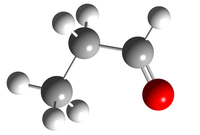syn-Propanal, v = 0
 | |
|---|---|
| Species tag | 058505 |
| Version | 2* |
| Date of Entry | Jan. 2018 |
| Contributors | O. Zingsheim H. S. P. Müller |
|
There are two conformers in propanal caused by the
internal rotation of the aldehyde group -CHO.
The syn-conformer is the lowest energy
conformer. It has all the heavy atoms in the
ab-plane; for this matter, it is sometimes
called cis. The two equivalent
gauche-conformers are approximately
420 ± 27 cm–1
higher in energy as derived from relative intensity
measurements. Other measurements largely support
this value, even though they show some scatter.
The first entry from Dec. 2008 has been revised
considerably. Even though internal rotation of the
methyl group has been resolved in the vibrational
ground state only in part in the laboratory, it does
matter in some sources with narrow lines. | |
| Lines Listed | 41020 |
| Frequency / GHz | < 1500 |
| Max. J | 100 |
| log STR0 | -9.0 |
| log STR1 | -6.0 |
| Isotope Corr. | -0.0 |
| Egy / (cm–1) | 0.0 |
| µa / D | 1.71 |
| µb / D | 1.85 |
| µc / D | |
| A / MHz | 16669.63 |
| B / MHz | 5893.504 |
| C / MHz | 4598.982 |
| Q(300.0) | 82649.4356 |
| Q(225.0) | 53653.0617 |
| Q(150.0) | 29191.4761 |
| Q(75.00) | 10319.3299 |
| Q(37.50) | 3650.8629 |
| Q(18.75) | 1293.1024 |
| Q(9.375) | 458.9411 |
| Q(5.000) | 179.9812 |
| Q(2.725) | 73.3134 |
| detected in ISM/CSM | yes |